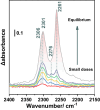Highly defective ultra-small tetravalent MOF nanocrystals
- PMID: 38653991
- PMCID: PMC11039632
- DOI: 10.1038/s41467-024-47426-x
Highly defective ultra-small tetravalent MOF nanocrystals
Abstract
The size and defects in crystalline inorganic materials are of importance in many applications, particularly catalysis, as it often results in enhanced/emerging properties. So far, applying the strategy of modulation chemistry has been unable to afford high-quality functional Metal-Organic Frameworks (MOFs) nanocrystals with minimized size while exhibiting maximized defects. We report here a general sustainable strategy for the design of highly defective and ultra-small tetravalent MOFs (Zr, Hf) crystals (ca. 35% missing linker, 4-6 nm). Advanced characterizations have been performed to shed light on the main factors governing the crystallization mechanism and to identify the nature of the defects. The ultra-small nanoMOFs showed exceptional performance in peptide hydrolysis reaction, including high reactivity, selectivity, diffusion, stability, and show emerging tailorable reactivity and selectivity towards peptide bond formation simply by changing the reaction solvent. Therefore, these highly defective ultra-small M(IV)-MOFs particles open new perspectives for the development of heterogeneous MOF catalysts with dual functions.
© 2024. The Author(s).
Conflict of interest statement
The authors declare no competing interests.
Figures





References
-
- Wang Y, Herron N. Nanometer-sized semiconductor clusters—materials synthesis, quantum size effects, and photophysical properties. J. Phys. Chem. 1991;95:525–532. doi: 10.1021/j100155a009. - DOI
LinkOut - more resources
Full Text Sources
Research Materials
Miscellaneous

